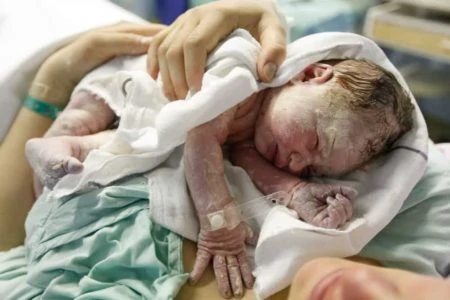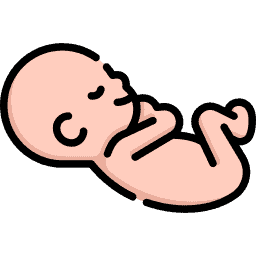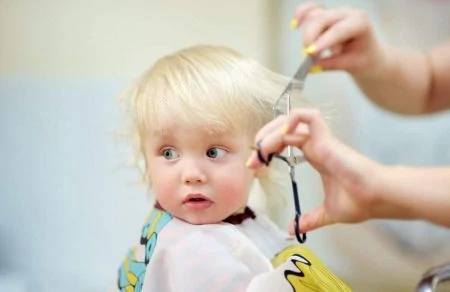It can be a little startling if your newborn comes out with a thin layer of hair all over their tiny body.
This hair is called lanugo and is common in newborns — especially if they’re born prematurely. But don’t worry, it won’t last forever.
In this article, our medical team will discuss what lanugo is, what causes it, and whether it can grow back later in life.
Key Takeaways
- Lanugo is fine, unpigmented hair that grows on babies during pregnancy, and usually sheds before birth or within the first few weeks of life.
- This hair serves a purpose by helping vernix adhere to the baby’s skin, protecting it from amniotic fluid and stimulating growth.
- About 30% of newborns have lanugo, which generally falls out naturally, but may persist for a few months.
- A patch of hair near the spine could be a sign of a condition called spina bifida, which is a congenital disability affecting the spine.
What Is Lanugo?
Lanugo is fine, unpigmented hair that begins to grow on babies from the fourth or fifth month of pregnancy (1).
It’s the first hair that grows from the follicles. This body hair grows everywhere on your newborn, except for the palms, lips, and soles of the feet.
Premature babies tend to have more lanugo when they’re born. Although some full-term babies still have some left by the time they’re born, most shed this hair inside the womb before the eighth month.
Lanugo begins to grow on the scalp, where it spreads down the face, around the eyebrows, nose, and forehead. It then continues down your baby’s body until it reaches their feet.
When it begins to shed inside the uterus, the hair incorporates into the amniotic fluid.
You know that first dark green squirt of meconium poop our lovely newborn greets us with? Yeah, we have lanugo to thank for that. It dissolves in the amniotic fluid, which the baby then swallows and later disposes of in their diaper.
When your baby sheds the lanugo, two types of hair replace it: vellus (fine hair) and terminal (thick hair). Terminal hair is what we have on our scalp, arms, and legs.
What’s the Purpose of Lanugo?
Lanugo serves a great purpose inside the uterus. It helps the cheese-like substance, called vernix, to adhere to your baby’s skin by acting as a physical anchor.
This, in turn, helps the vernix fulfill its purpose of protecting your baby’s skin from the amniotic fluid.
Lanugo also helps to increase your baby’s growth rate around mid-gestation. Amazing, isn’t it? But then, toward the end, it decreases the growth rate (2).
Lanugo hairs send vibrations through the vernix every time your baby moves. When these reach the amniotic fluid, they activate sensory receptors that connect to the nerve endings. These will ultimately end up stimulating your baby’s growth.
Once it gets closer to the last month, babies shed the lanugo hairs. The stimulation stops, and the baby’s growth rate slows.
How Long Does Lanugo Remain After Birth?
About 30% of babies still have lanugo when they’re born. This is no big deal. You may not even notice it right away since it hides under the vernix.
If newborn body hair is still present, don’t worry. It generally falls outs during the first few weeks. However, some babies may keep it for as long as a few months!
There is conflicting advice regarding the removal of lanugo if it persists.
Nonetheless, the general advice is to allow the hair to fall out naturally. A baby’s skin is sensitive, and massage could cause irritation, however gentle the products used may be. If you’re concerned that it’s taking too long, contact your pediatrician for advice.
Can Lanugo Regrow Later in Life?
Lanugo can occasionally regrow in older children or adults. However, this is a bigger mystery and might signify a more serious health issue.
When lanugo regrows on adults, it’s often confused with thin vellus hair. However, one way to check this is by examining the person’s overall health and the hair’s location. If it grows in new places, for example, the face or hands, it’s likely lanugo.
A Patch of Hair Near the Spine
Some mothers may notice that their newborn has a patch of hair near their spine, on their lower back. This is not lanugo and may be caused by a condition called spina bifida.
What is Spina Bifida?
Spina bifida is a congenital disability that affects the spine. It occurs when a baby’s backbone doesn’t develop properly. This may lead to a damaged spinal cord and nearby nerves, causing different disabilities.
The name spina bifida means “open” or “split” spine since sometimes this condition can cause an opening in the back.
In severe cases, the spine will be visible outside the skin, and the child will need surgery to correct it. However, in milder cases, there is no opening, and the defect is hidden (3).
This condition occurs during the first month of pregnancy as the baby’s spine and nearby nerves develop.
The severity of this condition varies greatly. Mild versions of this defect may only cause minor problems, if any at all. However, severe cases can lead to weakness, loss of bladder control, or even paralysis.
Spina Bifida Occulta
Children born with a mild version, called spina bifida occulta, may sometimes have it without even knowing. The defect sits under the skin and isn’t visible.
However, this type does leave one clue on the lower part of the spine. Sometimes it’s a birthmark, dimple, or patch of hair. An ultrasound of the spine can diagnose this condition.
When looking from the inside, the spinal cord is likely attached to tissue instead of being afloat in the spinal column. This may or may not cause any issues for the baby. Fortunately, most babies with this condition won’t experience any long-term problems.
Causes of Spina Bifida
Spina bifida generally occurs when your body doesn’t have enough folic acid during the first month of pregnancy. Folic acid is vital for tissue formation, cell growth, and development.
Low levels of this vitamin, both before pregnancy and in the early weeks, will increase the risk of spina bifida and other neural tube defects.
Sometimes it still occurs, even though the mother has a sufficient amount of the vitamin, although this is rare. In these cases, doctors suspect it could be a genetic defect.
Babies have an increased risk of being born with spina bifida if the mother ran a high fever during her pregnancy or took the drug valproic acid for epilepsy (4).











